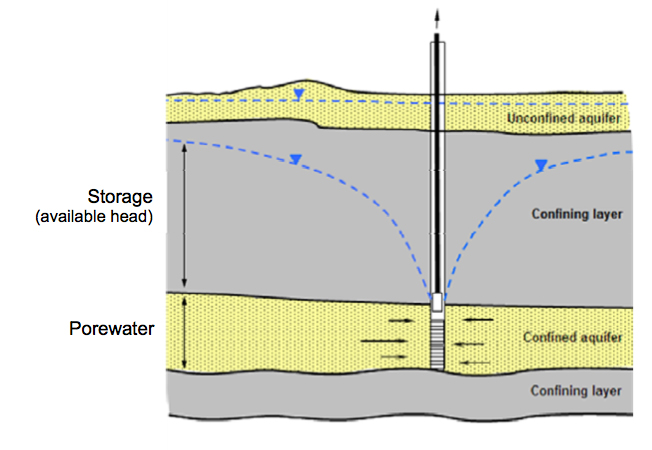How Much Groundwater is There?
How Much Groundwater is There?
Volumes of non-saline groundwater exist in two forms:
- The water that is situated within the pore spaces of granular formations or open fractures of less permeable rocks (total pore volumes),
- The water that forms the stored volume associated with confined aquifers. For unconfined aquifers, only the former volume applies.
 The total volume of pore water for a given formation is determined by determining the saturated thickness of an aquifer and multiplying by its average total porosity:
The total volume of pore water for a given formation is determined by determining the saturated thickness of an aquifer and multiplying by its average total porosity:
VT = A * d * η Equation (1)
In the above equation VT = Total Pore Volume (m3), A = Area, or areal extent of the aquifer (m2), d = Average Saturated Thickness, for a confined aquifer this is equal to the thickness of the aquifer (m), and η = Average Total Porosity, which is equal to the ratio of void space within a total volume of material.
Total storage volume, on the other hand, is calculated by assessing the volume of water that is released from storage as a confined aquifer is pumped. This volume occurs as a result of the expansion of water and compression of the aquifer as the hydrostatic pressure is reduced.
The amount of water available to be released from storage is defined as follows:
Vs =A*d*Ss*H Equation(2)
In the above equation Vs = Total Storage Volume (m3), A = Area, or areal extent of the aquifer (m2), d = Average Saturated Thickness – for a confined aquifer this is equal to the thickness of the aquifer (m), Ss = Specific Storage (m-1) and H = Available Hydraulic Head, which is equal to the average height of the water surface (or potentiometric surface) above the top of the aquifer (m).
These two volumes of water comprise the total resource of groundwater residing within a given basin or area. However, it is uncommon for water levels in a confined aquifer to be drawn down below the top of the aquifer. In cases such as this, significant aquifer damage can occur as a result of matrix collapse. Overuse of an aquifer can lead to such occurrences. That is why it is important to understand a groundwater system before it is exploited to any large extent.
The Results (volumes of non-saline groundwater)
Estimates of the volume of non-saline groundwater residing in the various aquifer types, (summarized below) were derived using the above equations and methodology.
| Aquifer type (km3) | Median pore volume (km3) | Median storage volume (km3) | Median useable volume (km3) |
| Alluvial | 34.3 (16.2 to 55.4) | 1.37 (0.6 to 2.2) | 22.7 (5.3 to 18.3) |
| Buried Channel | 135.3 (6.4 to 1,526) | 0.08 (less than 0.01 to 4.1) | 0.04 (less than 0.01 to 2.07) |
| Bedrock | 1,122 (166 to 5,620) | 12.5 (5.5 to 209) | 6.3 (1.1 to 18.1) |
Note: the range of values shown in brackets represents the 5th and 95th percentiles, respectively (1 km3 = 1 billion m3)
These estimates represent the first attempt at providing an overall assessment of provincial groundwater supplies. As such, the volumes generated represent a first order approximation and will no doubt be refined as more information on the subsurface is generated in the coming years, and interest in groundwater as a viable supply source grows. Total volumes, and useable volumes based on prevailing sustainable yield guidelines and policies, have been included.
Section 2: Alberta’s Water Balance and Inventory
Module 1: What do we know about groundwater today?
Module 2: How important is groundwater to Albertans?
Module 3: How much groundwater is there?
Module 4: Where’s the “good” water?
Module 5: What about the saline water?
